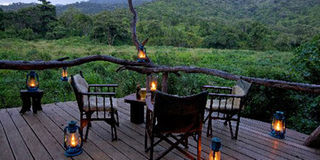Close to paradise in the sky forest

Lounging chairs on the deck with lamps at Kitich camp. PHOTO | Des Bowden
What you need to know:
- A deep pool along the river’s flow becomes ‘my’ pool and edged by the reeds, ferns, trees and rocks of every shape strewn around, it doubles as a private spa every afternoon – the perfect time after the sun has warmed the water.
- Camp life falls into routine easily: Mornings spent following the men at work as they chart the forest dynamics of one of Kenya’s last unspoilt indigenous forests, lunch at camp followed by lazy afternoons by the river. And then the nights – dark and pure.
- With a massif that stretches 80 kilometres, there’s tons to explore. Dr Luca Borghesio, who has been studying the forest dynamics of Mathews Range for the last seven years, suggests a walk to the cave where the Dorobo once lived.
I’m at my favourite spot at the river that flows from the high forests of Mathews Range down to the drylands and eventually seeps into Lorian Swamp.
It’s called Ngeng and not many people know about it, but for the Samburu of the massif that towers above the dry plains of the north, it’s their life-lung.
A deep pool along the river’s flow becomes ‘my’ pool and edged by the reeds, ferns, trees and rocks of every shape strewn around, it doubles as a private spa every afternoon – the perfect time after the sun has warmed the water.
It’s great to be back in Mathews Range. Everything is in place just as we left it a year ago.
WELL FED LIONS
The enormous granite boulders that have weathered eons and given the place its Samburu name, Soit Ng’iro – the place of brown (dark) rocks; the gigantic fig tree with three ‘pillars’ which doubles as the kitchen, the slate as a lounge where the camp fire is lit and our tents pitched in the shade of the towering trees.
Perched at 5,000 feet there is no human habitation above us.
The nearest village, Ngelai, is 15 kilometres below on the drylands. And to top it, there’s no connection to the outside world via mobile phones or internet for the next three weeks. This is my Shangri-la.
Camp life falls into routine easily: Mornings spent following the men at work as they chart the forest dynamics of one of Kenya’s last unspoilt indigenous forests, lunch at camp followed by lazy afternoons by the river. And then the nights – dark and pure.
The lion gives itself away with its roar. On the first night it walks past the camp, growling as we sit by the campfire.
“It’s probably killed a cow, so there’s no need to worry because it is well-fed.,” jokes Lyon Lekerpes. He’s not the same lion as the one of the previous year that ripped a tent apart.
With no other sound other than that of the natural world, our ears zero in on the denizens of the wild. The leopard’s cuff, the elephants’ trumpet, the cackle of the hyenas, the baboons squabbling and the birds chirping.
The metallic notes of the fruit bats and the soulful call of the wood owl drift by.
The black-headed oriole and chinspot batis – both insect-eaters – announce the dawn mixed with the loud calls of the Hartlaub turaco and the shrill of the African fish eagle.
NOT A SOUL IN SIGHT
With a massif that stretches 80 kilometres, there’s tons to explore. Dr Luca Borghesio, who has been studying the forest dynamics of Mathews Range for the last seven years, suggests a walk to the cave where the Dorobo once lived.
People of the forest, the Dorobo were hunter-gatherers who have now moved out of the forests and inter-married with neighbouring communities like the Samburu.
The forest floor is littered with dry crackling leaves. By a dry lugga, plants that look like cacti stand sentinel.
These are the Encephalarctos tegulaneus, an endemic cycad of Mathews Range. Fire resistant and growing five millimetres a year, a 10-foot cycad could be several centuries old.
There’s not a soul in sight at the abandoned Dorobo cave. Moving around the rocks, a fire’s been lit recently where the morans come to eat meat.
In another part of the forest, a huge fig tree has crashed to the ground bringing down others with it and opening a skylight in the forest.
“Forests are not static ecosystems. They are dynamic and change, sometimes very fast,” I recall Borghesio saying.
He reported a rare endemic fig tree in East Africa from Mathews Range– Ficus ottontifolia.
Previous records in Kenya are from south coast and western Kenya. It’s growing by the road, showing how much more can be discovered in the little-researched forest.




